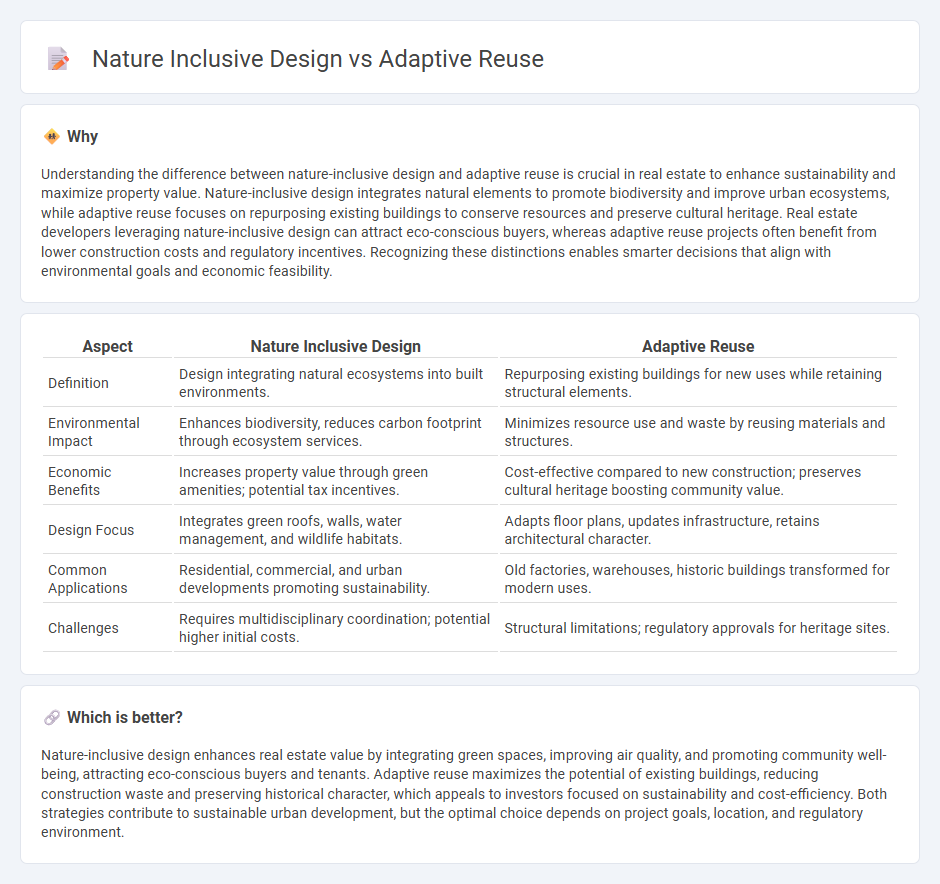
Nature-inclusive design integrates natural elements into real estate developments to enhance environmental sustainability and occupant well-being. Adaptive reuse focuses on repurposing existing structures to preserve cultural heritage while minimizing construction waste and reducing urban sprawl. Explore how these innovative approaches are reshaping the future of sustainable real estate development.
Why it is important
Understanding the difference between nature-inclusive design and adaptive reuse is crucial in real estate to enhance sustainability and maximize property value. Nature-inclusive design integrates natural elements to promote biodiversity and improve urban ecosystems, while adaptive reuse focuses on repurposing existing buildings to conserve resources and preserve cultural heritage. Real estate developers leveraging nature-inclusive design can attract eco-conscious buyers, whereas adaptive reuse projects often benefit from lower construction costs and regulatory incentives. Recognizing these distinctions enables smarter decisions that align with environmental goals and economic feasibility.
Comparison Table
| Aspect | Nature Inclusive Design | Adaptive Reuse |
|---|---|---|
| Definition | Design integrating natural ecosystems into built environments. | Repurposing existing buildings for new uses while retaining structural elements. |
| Environmental Impact | Enhances biodiversity, reduces carbon footprint through ecosystem services. | Minimizes resource use and waste by reusing materials and structures. |
| Economic Benefits | Increases property value through green amenities; potential tax incentives. | Cost-effective compared to new construction; preserves cultural heritage boosting community value. |
| Design Focus | Integrates green roofs, walls, water management, and wildlife habitats. | Adapts floor plans, updates infrastructure, retains architectural character. |
| Common Applications | Residential, commercial, and urban developments promoting sustainability. | Old factories, warehouses, historic buildings transformed for modern uses. |
| Challenges | Requires multidisciplinary coordination; potential higher initial costs. | Structural limitations; regulatory approvals for heritage sites. |
Which is better?
Nature-inclusive design enhances real estate value by integrating green spaces, improving air quality, and promoting community well-being, attracting eco-conscious buyers and tenants. Adaptive reuse maximizes the potential of existing buildings, reducing construction waste and preserving historical character, which appeals to investors focused on sustainability and cost-efficiency. Both strategies contribute to sustainable urban development, but the optimal choice depends on project goals, location, and regulatory environment.
Connection
Nature-inclusive design in real estate prioritizes integrating natural elements into built environments to enhance biodiversity and occupant well-being, while adaptive reuse focuses on repurposing existing structures to reduce environmental impact. Both approaches promote sustainable development by conserving resources and minimizing urban sprawl, contributing to resilient and eco-friendly communities. Their synergy supports real estate projects that balance ecological preservation with innovative, functional spaces.
Key Terms
Repurposing (Adaptive Reuse)
Adaptive reuse involves repurposing existing buildings to extend their lifecycle, reduce demolition waste, and conserve resources by preserving structural elements and materials. This approach supports sustainable urban development by maintaining cultural heritage and adapting spaces for modern use without extensive new construction. Explore how adaptive reuse can transform environments while promoting sustainability and economic efficiency.
Biodiversity (Nature Inclusive Design)
Nature inclusive design prioritizes maintaining and enhancing local biodiversity by integrating natural habitats and native species into urban development projects, unlike adaptive reuse which primarily focuses on repurposing existing structures to extend their lifecycle. By embedding green corridors, wildlife-friendly landscapes, and diverse plantings within built environments, nature inclusive design fosters ecological resilience and supports ecosystem services crucial for urban sustainability. Explore more about how nature inclusive design can transform urban spaces to benefit biodiversity and human well-being.
Sustainability
Adaptive reuse conserves resources by repurposing existing buildings, significantly reducing construction waste and embodied carbon emissions. Nature inclusive design integrates green infrastructure, promoting biodiversity and enhancing ecosystem services within urban environments. Explore how combining these approaches can drive innovative sustainability solutions for future development.
Source and External Links
Adaptive Reuse - This is the process of reusing an existing building for a purpose other than its original one, often retaining its historic features while prolonging its lifespan.
A Complete Guide to Adaptive Reuse in 2023 - This guide outlines the sustainable practice of adaptive reuse, highlighting different types such as renovation, integration, and preservation.
What is Adaptive Reuse? - Adaptive reuse involves repurposing buildings for new uses, maintaining their historic or cultural significance while preventing demolition and promoting sustainability.
 dowidth.com
dowidth.com